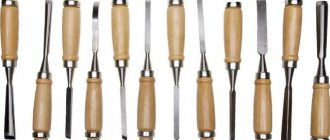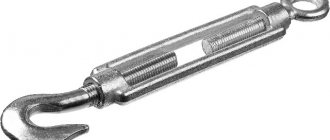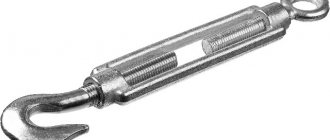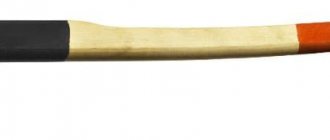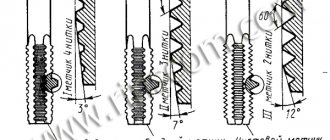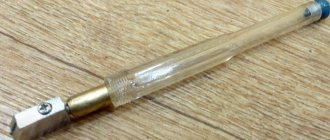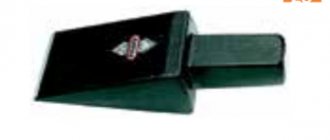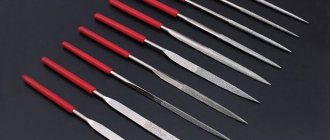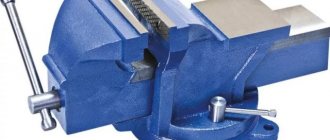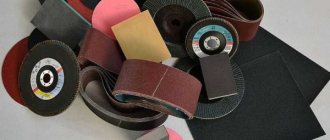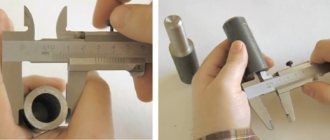The mallet is an integral part of the tools of plumbing and carpentry masters; it is also used in other works.
This hammer is still the same percussion instrument, but performs completely different tasks, unlike its metal counterpart.
In addition to the classic wooden version, which every schoolchild met in labor lessons, there are highly specialized types of it, which expands their scope of application.
We will talk about why a mallet is needed, how and what it is made of, the main types, and the nuances of choosing it for specific tasks.
What is a mallet for?
Not very common in everyday life, the mallet has found its use where blows with an ordinary hammer can cause damage to the material being worked with.
The tool is often used for straightening sheet metal. A good example in this case is the straightening of a car body.
When carrying out roofing work, in particular on complex roofs, where processing of joints and edges at the intersection of seam joints is required, this particular tool is also used.
And the folding of the metal itself is done with a mallet.
As for working with wood, the mallet is used for tamping, for example, furniture elements during assembly, or laminate flooring when laying it.
Carpenters often use the tool in conjunction with a chisel or chisel, especially if the handles of the latter are made of wood or plastic.
Advantages and disadvantages
For many years, the mallet has been used in construction, repair and decoration. Therefore, it’s time to highlight its positive and negative sides:
- A large variety of tools. There are models on sale that differ in weight even by tens of grams. Therefore, you can always choose the variety that best meets your requirements. It is because of this that workers always have a whole set of mallets, one for working with tiles, another for roofing, and a third for laying porcelain tiles.
- Affordable price. For up to 1000 rubles you can find a quite decent tool that will perform the task and will not break. There are more professional, balanced options that cost up to 5 thousand rubles, but it is not advisable to buy them for your home.
- They do not damage the material when working with it. Of course, in many respects everything depends on the quality of the purchased product and the ability to work with it. But, if you purchased a quality product, then be sure that no traces will remain after processing. There will be no stripes or cracks, no scraps of handle or striker. The absence of cracks depends on the ability of the striker material to absorb impact upon impact. On the contrary, if depreciation is not needed, then you can choose a special option, which is actively used when assembling furniture.
- High strength. You should not take into account the cheapest options, where the handles are made of fragile plastic and wood. Products whose manufacturers do not save money do not have metal handle fatigue, no cracks in the wood when drying out, and no other defects or damage during operation. If products with wooden handles begin to dry out, which leads to loosening, then they should be placed in water so that the wood swells. They do the same with ordinary hammers.
- There are universal options, but they are few. For example, the same mallets for installing plastic windows. They have a rubberized base on one side and a metal base on the other. This allows you to make the product universal, heavy, weighty, and easy to use. On the one hand, we use this mallet during installation, on the other hand, we hammer the dowels into the wall with it.
- You can make it yourself. This allows you to create your own mallets. As a rule, only wood products are suitable for this option. The main thing is to center the handle when connecting so that the blow is balanced, otherwise the handle will quickly break at the base.
Like any other tool, a paving slab mallet has its drawbacks. These include:
- Not being repaired. This happens mostly with wood products. They dry out and then begin to loosen. You can put it in water, but this will solve the problem only for a while. A broken metal handle also cannot be repaired, since, to make it lighter, it is often made of non-ferrous metals or a steel alloy that cannot be welded at home.
- Not suitable for use as a hammer. Despite the fact that the shape is similar, they cannot be used to hammer nails and other objects. This will cause the firing pin to break or become deformed, ruining the product. At most, with such mallets you can hammer plastic dowels into the wall, into pre-prepared holes. A paver mallet is only suitable for this job, despite its size.
- Few universal options. This makes it necessary to spend more money, buying a different version for each type of work.
- A good tool is expensive. Well-known manufacturers, whose brand many are chasing, supply products to the market at a cost of 1,500 rubles. Many people don’t want to spend money, so they buy analogues made from cheaper steel.
Device and characteristics
Structurally, the tool consists of a handle and a striking part - a striker, which is made of various materials and different shapes, depending on the purpose.
The handle is inserted into the through hole of the striker with a slight taper on the side of its rounding.
This design prevents the latter from breaking during operation.
Striker and handle material
Hard wood, including birch, is used to make the mallet handle.
Some models have a rubber coating where the hand holds the tool.
Less common are metal, plastic and fiberglass handles.
As for the striker, for its manufacture they use:
• Wood of dense and sticky species, for example, butt birch, elm, hornbeam.
• Hard rubber – for tools used to work on materials that can easily be pressed.
• Fluoroplastic is a polymer with high chemical resistance. This material is not destroyed by water and does not dissolve in it, and is also insoluble or poorly soluble in most organic solvents, having a low wear value.
NOTE:
Drying oil serves as a protective coating for wooden strikers and handles.
Striker shape
Depending on the task, select a tool with the appropriate cross-sectional shape of the head:
• Round – typical for tools designed to perform straightening and installation work; it is also used when laying paving slabs.
• Rectangular – designed for chiselling work, for example, paired with a chisel or chisel, roofing work and folding.
• Square – it is mainly used for folding and roofing work.
NOTE:
The tool head can be either straight or wedge-shaped.
Manufacturing [edit | edit code ]
Material for the mallet: hornbeam, elm, butt birch and other viscous and heavy wood species. For the striker - the butt part of the birch; with the development of polymer materials, fluoroplastic began to be used; for the handle - ordinary birch wood or wood of other dense species. Finish: drying oil coating.
The handle is inserted not from below, but from above the striker [ clarify
], from the side of the rounded edge, into a through hole that has a slight taper. Under this condition, the striker cannot fall off the handle during operation, but on the contrary, the more the striker is pushed onto the end of the handle, the more firmly the handle sits in it.
In order to facilitate the most difficult technical operation in the manufacture of a mallet - chiselling a hole for the handle - you should first drill a through hole with a 25 mm drill, then widen the hole with a chisel.
For metalworking of parts and blanks, for the manufacture of wooden structures, carpentry and joinery craftsmen use a large number of tools, which make it possible to create high-quality, practical and necessary things in everyday life or to reconstruct them. One of the important tools of professional craftsmen is a mallet. In specialized stores you can see several types of this product, which differ not only in appearance, but also in price range, as well as strange manufacturing.
Dimensions and weight of mallets
Considering the wide range of tasks for which a mallet is used, its weight ranges from 225 - 450 g for light models, 450 - 900 g for medium ones, and more than 900 g for heavy ones.
At the same time, the dimensions visually may not correspond to the weight, for example, a heavy tool may be small, because sometimes, to further weight the striker, lead is poured into its center.
As for the length of the handle, it can vary widely, since it is believed that the longer it is, the stronger the blows can be performed.
A classic wooden instrument weighs on average about 300 g and is 30 cm long.
Types of mallets and their prices
Standard mallets are divided into several types:
Wooden
The classic version, which is used when molding structures and materials, in dismantling and assembly work.
The cost of a budget instrument ranges from 80 to 400 rubles.
The price of high-quality models can exceed 2.5 thousand rubles.
Rubber
For materials that are highly pressure sensitive.
The tool is usually equipped with a wooden or metal handle.
Body work is performed with just such a mallet, since the increased elasticity of the rubber prevents the formation of chips in the paintwork.
In addition, the tool is also common among roofers working with copper, aluminum and galvanization.
The average price is about the same as the previous option.
The price of a large and heavy instrument reaches 3 thousand rubles.
There are also models of 10 thousand.
Inertialess
It is used in cases where increased requirements are placed on maintaining the integrity of the surface of the material.
A striking example is furniture assembly.
Inside the striker of such a tool there is an elongated cavity with a metal ball or shot, which upon impact prevents the striking part from rebounding.
For a good tool you will have to pay 200 - 400 rubles.
Special mallets include:
Construction
With a head made of rubber material, used for installation of soft metal and metal-plastic structures.
Zhestyanitskaya (metalworks)
For sheet metal work.
This mallet is suitable for straightening and folding material.
The round handle has a slight taper on one side.
The firing pin is made in the form of a rectangle.
Turning
It is used for the same purposes as tin, however, all its parts are made on turning equipment.
Carpentry
Designed for performing chisel work with a chisel or chisel.
The sides of the instrument are flat, wide, parallel to each other.
One side of the striker is flat, and the opposite side is rounded, while the ends relative to the axis of the handle are cut at an angle of 6 - 7 degrees and are not parallel to it.
This mallet is also well suited for adjusting the planing tool, namely, knocking out the incisors.
Plastic for roofing work
Used for installation using double standing seam technology.
The strikers are made of impact-resistant polyethylene.
Tiler's mallet
The main feature is a rubber head with a round heel.
For laying paving stones, models weighing up to 400 g are used, and for paving slabs - 600 - 800 g.
Mallet "Carver's Hammer"
It has an oblong shape, reminiscent of a one-handed rolling pin or a hand bell.
This wood carving hammer is made from hardwood.
Another name is a sculptural mallet.
The price of a quality instrument is within 5-6 thousand rubles.
Double-sided plastic hammer
A tool with round heads made of plastic, such as TPR.
This mallet is intended for construction and installation work.
Textolite mallet
It has electrical insulating properties and is intended for bodywork and jewelry work.
It is irreplaceable when working where there is a need to prevent sparks from static electricity (straightening gas tanks, etc.).
Each type of mallet is universal, in other words, it can be used not for its intended purpose, but depending on the characteristics of the material being processed and the planned result.
Description
A mallet is a percussion instrument that is made of durable wood with a high level of density. The history of the creation of the mallet goes back to ancient times, when the Slavs used a large wooden tool to caulk residential and commercial buildings, as well as boats before launching them into the water. The modern name of the device comes from the Slavic word cue. Professional craftsmen use this product when working with fragile materials, the integrity of which can be damaged by strong blows from a regular hammer. The mallet consists of the following parts:
To make the handle, manufacturers use dense wood, as well as plastic, metal and fiberglass. To prevent the tool from slipping during operation, some models have rubber pads. The main design feature of the tool is the mounting of the handle on the front side of the striker in the place of the through hole. The cone-shaped shape of the handle at the point of fixation prevents the head from coming off during operation.
To produce the impact part, dense, viscous and hard wood, hard rubber and polymers that have a high chemical density are used. The polyurethane head, which has improved properties and parameters, is in great demand. To increase the service life of wooden parts, manufacturers coat them with special protective agents, as well as drying oil.
The mallet is used to perform the following types of work:
- straightening metal sheets;
- straightening the car surface;
- installation of roofing materials;
- folding of metal edges;
- Furniture assembly;
- laying tiles and paving stones;
- wood carving;
- laying laminate flooring.
This tool is used in conjunction with a chisel and chisel. Due to its wide range of applications, the mallet has several shapes of the bike head:
The maximum weight of one tool can reach 1 kg, and the size of the product does not depend on its weight. The length of the handle determines the force of impact, as well as the purpose and model of the tool.
Modern manufacturers produce several types of mallets.
- Wooden is a traditional tool that is used to assemble, disassemble and shape various structures. Advantages – universal purpose, affordable price.
- Rubber is a special product for working with fragile materials that have a high level of sensitivity to mechanical stress. Advantages - the ability to work on painted surfaces made of copper, aluminum or galvanized.
- Inertia-free is a unique tool that allows you to avoid chips and cracks as much as possible. The main feature of this product is the presence of a void inside the bike, which is filled with small iron balls or small shot to reduce the level of inertial action upon impact.
- Construction - a special model that is used to work with soft structures made of metal or metal-plastic.
- Metalworking (straightening) is a working tool for tinsmiths who straighten and fold sheet metal. A special feature is the presence of a slight narrowing on the round handle. The shape of the bike is rectangular.
- Lathe is an analogue of a metalworking tool, all the parts of which are made using a lathe.
- Carpentry is a tool that is designed to perform chiselling work using a chisel or chisel. The peculiarity is the presence of wide and parallel sides, one of which is flat and the other rounded.
- Plastic - a device that is used to perform work using the double standing seam method. The material of manufacture is impact-resistant polyethylene.
- Sculpted - a carver's hammer, which is shaped like a rolling pin with one handle and is used for carving wood.
- For tiles - a working tool for a master who works with tiles and paving stones. A special feature is the presence of a rounded head with a rubber heel.
- Double-sided - a modern model that has two working sides and is widely used for construction and installation work.
- Textolite is a specialized tool that has electrical insulating properties and is used in jewelry production and car repair.
- With a replaceable head - advanced equipment that allows you to change attachments depending on the type of work performed.
Which mallet should you choose?
For most carpentry work, you should use a mallet with a wooden head.
In this case, the dimensions and weight are selected individually. Particular attention should be paid to the wood itself.
As already mentioned, it should be a heavy and sticky breed.
It’s good if the striker and handle are made of different wood, which will reduce the impact on your hands.
An external inspection will help you avoid troubles in the form of poorly processed surfaces of both the handle and the head itself.
In addition, the drying oil coating will protect the instrument from drying out.
As for the rubber tool, it is considered more universal, and the selection criteria are as follows:
- Weight. Obviously, as this indicator increases, the impact force also increases. But there is one caveat: a fairly heavy tool requires more impact force from the worker, which will lead to rapid fatigue. Weight is determined by experience, personal feelings and depending on the work ahead.
- Length – selected based on the preferences of the person who will work with the tool. A long handle will provide a stronger blow.
- Handle. In addition to wooden and plastic options, attention should also be paid to fiberglass handles. They are highly durable, do not dry out and do not lose their original shape over time. In addition, fiberglass is resistant to organic solvents.
- Striker size. For rough work, a tool with a large impact head is selected, while delicate tasks require small strikers.
If the tool store does not have a mallet that can satisfy any special preferences of the master, you can assemble it with your own hands according to individual sizes.
Rules for selection and operation
The choice of the necessary tool is influenced not only by the type of planned work, but also by the properties of the working surface and the parameters of the desired result. The most popular is a wooden instrument, which has the following characteristics:
- different wood in the handle and striker;
- absence of mechanical damage and burrs on the wooden surface;
- the presence of a protective coating of drying oil.
When choosing a rubber tool, you must rely on the following characteristics:
- weight;
- handle size;
- material of manufacture;
- striker diameter.
A tool that is heavy and has a long handle is capable of striking with greater force, which requires greater physical effort from the master and contributes to fatigue.
Experienced craftsmen recommend paying attention to modern models of instruments that are made of fiberglass. This material is not only highly durable and not affected by solvents, but also has a long service life while maintaining its original shape and properties.
For thin and delicate types of work, you should opt for mallets with a small head, which has a small force and impact area.
To perform work on light-colored surfaces, craftsmen advise purchasing mallets with white rubber boots. The black rubber work surface leaves streaks that are difficult to remove and can ruin the appearance of the structure. The principle and technology of using a mallet is the same as when working with a simple hammer, but before applying the first blow, you must know the properties of the material and its strength. The first contact of the tool with the working surface should have a low amplitude, which can subsequently be increased.
Working with tiles involves using light blows with a rubber tool on the protruding areas
Particular attention should be paid to working in the corners of the product, where cracks and chips may appear. Experts recommend purchasing goods only in specialized stores that have quality certificates and all permitting documents
A quality product must comply with the established GOST 19645.
Criteria for choosing a rubber mallet
Each rubber mallet may differ from another hammer not only by the manufacturer, but by a number of other technical parameters:
- weight - the greater the weight of the tool, the more powerful the blow delivered by the hammer. However, it should be noted that a fairly heavy rubber mallet will require greater physical impact force. This can lead to rapid worker fatigue. Lighter mallets include hammers weighing from 225 to 450g, and heavier ones - from 900 to 1100g. At the same time, a small mallet will not necessarily be light. In some cases, it is additionally made heavier by pouring lead into the center of the striker;
- length – depending on the type of work being carried out, mallets may have a run-up in the length of the handle. As a rule, it is believed that the longer the handle, the stronger the blow. Here, each specialist must individually select the length of the mallet with which he will be comfortable working;
- handle - some manufacturers make the handle from a special material - fiberglass. It is considered more durable, does not lose its shape over time and does not dry out under the influence of various organic solvents;
- striker size - small heads are used for more delicate work, large heads for rough work;
- material – it will be an advantage if the handle and striker are made of different types of wood. In this case, the impact on the hands from the blow will become softer.
What you need to know about mallets?
In most cases, mallets are sold on the construction market with a head made of black rubber.
During operation, such models leave marks at the point of contact of the striker with the material being processed.
An example is the installation of plastic windows with a white frame, where such marks are especially noticeable.
However, a rubber hammer is indispensable in such work.
The solution is to use white rubber mallets, which are less popular, but do not leave marks.
How to do it yourself?
Anyone can make a mallet themselves - you just need to prepare the necessary materials. The step-by-step process is as follows:
- the handle blank is turned on a lathe; it should be round in shape, which will give the tool a more convenient look;
- where the head will be located in the future, a small protrusion is made;
- the material for the working part is simple rubber, sometimes leather; to create the working part, you may need up to fifty cut circles, in which an additional hole is made for the handle;
- the circles are connected to each other using PVA glue;
- the workpiece is placed under a press to better set the individual parts, while the adhesive composition must dry completely;
- the head is secured to the handle using a metal washer on top, which will not allow the working part to fly off;
- As an additional fastening, you can use nails driven into the end or wound twine.
To learn how to extend the life of a rubber mallet, see below.
How to use a mallet?
The process of working with a mallet is practically no different from a hammer.
The only thing you need to be able to do is control the force of impact on different materials.
Without relevant experience, you should start with a small amplitude of tapping and then evaluate the result.
When leveling sheet metal of small thickness, care should be taken to provide a flat wooden backing to compensate for the excess force applied.
The tool should be operated in such a way that the first striker is in contact with the material being processed along its entire length.
Otherwise, dents may form on the metal.
When working with a chisel or chisel, blows should also be applied with adjusted force so as not to cut off excess.
The use of a rubber mallet when laying tiles is due to the shock-absorbing ability of its striker.
To align the material along the required axes, lightly tap on the protruding sides of the surface.
When it comes to laying tiles, strong impacts should be avoided, especially in the corners.
Although the mallet is designed for this type of work, excessive tapping force can still damage the fragile material.
And the tile itself will immediately shrink excessively, and you will have to dismantle it and add mortar.
